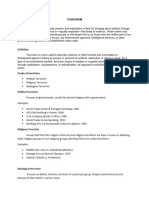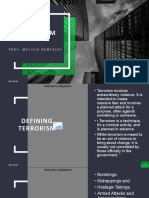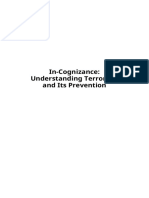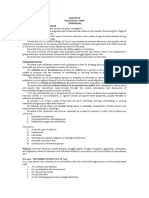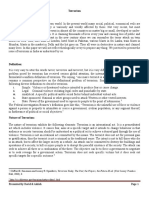What is Terrorism?
According to Google and other sites that,the terrorism refers to the use of violence,
terrifying, or threats by non-state actors or groups to achieve political, ideological, or
religious goals. It targets civilians, institutions, or governments to implant fear and
disturb social norms. Terrorism often rises above national boundaries and
challenges the supremacy and stability of states.
According to FBI(federal bureau of investigation).It is an agency of (u.s) that defines
"The unlawful use of force or violence against persons or property, illegal violence or
threats to harm people, damage property, or pressure to governments. The main
goal is to scare or control others to achieve political or social aims.
Terrorism is not unique to the 20th and 21th century but terrorism existed in the
18th century in forms like revolutionary movements and acts of violence against
ruling authorities. For example, during the French revolution 1789, the American
revolution of 1775 and Irish rebellion of 1798.
The topic of terrorism is both complex and emotive.
Complex:Terrorism involves numerous aspects of human experience, including
politics, psychology, philosophy, military strategy, and history, among others.
Emotive:The experiences of terrorists arise strong feelings.those who justified
terrorism often have harsh emotions regarding the perceived moral correctness,
fairness, or justification of violence.
Types of terrorism
Various attempts have been identified among types of terrorist activities. It is vital to
bear in mind, however, that there are many kinds of terrorist movements, and no
single theory can cover them all. Not only are the aims, members, beliefs, and
resources of groups engaged in terrorism extremely diverse, but so are the political
contexts of their campaigns.
1.Social Revolutionary Terrorism:-
This type of terrorism happens when people believe society needs a big change.
They use violence to fight against things like unfair social systems and try to make
society more equal. For example, in the 1960s, the Weather Underground in the U.S.
used bombings to protest against the government and social inequality.
2.Nationalist-Separation Terrorism:-
This happens when a group wants to create its own country for a specific ethnic or
national group. They think using violence is necessary to break away from the
country they are in. For example, the Basque separation group ETA in Spain fought
for an independent Basque country.
�3.Non-Political Terrorism:-
Non-political terrorism is when people carry out violence without any political or
ideological goal. It may be caused by personal reasons or mental health issues. For
example, mass shootings or bombings done by individuals without a clear reason
for their actions are examples of non-political terrorism.
4.Religious Fundamental Terrorism:-
This type of terrorism is based on extreme religious beliefs. People who follow this
ideology believe violence is okay to protect or spread their religion. Groups like Al-
Qaeda or ISIS stands for (Islamic State in Iraq and al-Sham) have used violence to
enforce their clarification of Islam.
5.Communist Terrorism:-
Communist terrorism happens when groups want to create a communist country,
often using violence. They believe that a revolution is necessary to overthrow
capitalist systems. The Shining Path group in Peru used violence to push for a
communist revolution in the 1980s and 1990s.
6.Quasi-Terrorism:-
Quasi-terrorism is a type of violence that looks like terrorism but doesn’t have a
clear political goal. It may involve acts like kidnapping or bombings, but the goal isn't
to bring about a political change. It’s often seen as extreme violence, but it lacks the
organization and clear objectives of typical terrorist groups.
7.State Terrorism:-
State terrorism happens when governments use violence or fear to control their
people or stop opposition. This can include things like torture, killings, or
imprisoning people. An example is the Syrian government's actions under Bashar al-
Assad, using violence against its own people during the civil war.
Causes of Terrorism
1. Psychological Perspective
Some people turn to terrorism because they feel frustrated, treated unfairly, or want
revenge. They may feel lonely, angry, or helpless, and terrorism gives them a sense
of purpose or a group to belong with them.
2. Ideological Perspective
Terrorism can come from strong beliefs, like political, religious, or social ideas.
Groups may think their beliefs are the only right ones and use violence to spread or
enforce them.
�3. Strategic Perspective
Terrorism is used as a plan or policy to achieve goals like power, control, or
attention. Groups may choose violence because they think it’s the best way to make
others listen, weak enemies, or get what they want.
Harms of Terrorism
Loss of Life
Terrorism often leads to the death of innocent people. This causes pain and
suffering for families and communities.
Economic Damage
Terrorism destroys businesses, markets, and leads to costly damages. It harms a
country’s economy by discouraging investment and tourism.
Political Instability
Terrorism can destroy governments and create anarchy. It can lead to changes in
leadership or even cause entire countries to become unstable.
Impact on Social Services
Terrorism can destroy important things like schools, hospitals, and infrastructure.
This makes it harder for people to access basic services like education and
healthcare.
Psychological Damage
The fear and trauma caused by terrorism affect both victims and those who witness
it. People may suffer from long-term mental health issues like anxiety and
depression.
Destruction of Infrastructure
Terrorism often targets buildings, roads, and other important structures. This can
leave communities without essential services like clean water, electricity, or
transport systems.
Disturbance of Daily Life
Terrorism can make people live in constant fear. It leads to harsh security and
changes in how people go about their daily lives, like at airports or public places.
Conclusion:-
Terrorism is an unlawful act,
It has a long history of being used to achieve political, religious and ideological
objectives.
Terrorism can be conducted through firearms, explosive devices and biological,
chemical and nuclear materials.Terrorism causes fear, harm, and division in
society,targeting innocent lives and disrupting peace. It challenges stability and
�security, making it essential to address through unity, justice, and efforts to
eliminate its root causes. Building understanding and promoting peace are key to
preventing its spread.








